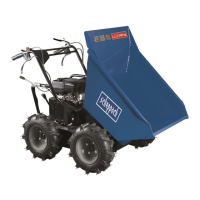15
m NOTE
If full loading or transporting heavy loads, the emp-
tying of the dump box (8) is carried out with the help
of a second person.
• After emptying the dump box (8) you can lower it
as shown in Fig. 2 Pos.A4. Lock the dump box (8)
by selecting the xation dump box (6) to position
(A2) as shown in Fig. 3.
Starting engine (Fig.1/4/14)
Cold starts
• Turn the choke lever (16) at the engine to position
(Fig.14).
• Set the throttle lever (1) at the handlebar to half-
way position.
• Turn the engine switch (2) to “ON” position.
• Set the fuel cock (15) to position
• Pull the starting rope (18) slowly several times to
allow the fuel to ow into the engine’s carburetor.
- Hold the start handle (18) rmly and pull the
rope out a short distance until you feel some
resistance.
- Pull the rope smoothly and briskly, and allow
the rope to return gently. Do not let the rope
snap back. If necessary, pull the rope several
times until the engine starts.
• Allow the engine to run for several seconds to
warm up.
• Allow the engine to run for several seconds to
warm up. Then, gradually move chock lever (16)
to position .
m NOTE
If the engine is already warm, it is not required to use
the choke for re-starting.
Warm starts
• Set the throttle lever (1) on the handlebar at half-
way position.
• Turn the engine switch (2) to pos. “ON”.
• Set the fuel cock (15) to the position
• Pull the starting rope (18) slowly several times to
allow the fuel to ow into the engine’s carburetor.
• Pull the rope smoothly and briskly, and allow rope
to return gently. Do not let the rope snap back.
m Refuel in a well-ventilated area with the engine
stopped. If the engine has been running, allow it
to cool rst. Never refuel the engine inside build-
ings where gasoline fumes may reach ames or
sparks.
Fuel is highly ammable and explosive. You can
get burned or other serious injuries when han-
dling fuel.
• Switch o the engine and keep it away from heat,
sparks and ames.
• Refuel the engine only outdoors.
• Immediately clean up spilled fuel.
9. Functions and controls
m Important!
The machine must be fully assembled before the rst
use!
Please also refer to the engine manual
Engine switch (Fig.1/Pos.2)
The engine switch (2) enables and disables the igni-
tion system. The engine switch (2) must be in “ON”
position to start the engine. The engine switch (2)
must be in the “OFF” position to stop the engine.
Clutch control lever (Fig.1/Pos.4)
• Actuating the clutch control lever (4)
- Clutch is engaged (Press the latch (Figure 8 /
A), then you can press the clutch control lever
downwards)
• Release the clutch control lever (4)
- Clutch is disengaged.
Throttle control (Fig.1/Pos.1)
• Put the throttle control (1) on low speed (L) or high
speed (H) or an intermediary position between L
and H to increase or decrease the speed of engine.
Left steering lever (Fig.1/Pos.5)
Operate the lever (5) to turn left.
Right steering lever (Fig.1/Pos.3)
Operate the lever (3) to turn right.
Gear selection lever (Fig.1/Pos.7)
• The gear selection lever (7) controls forward or
reverse movements of the machine.
Fixation dump box (Fig.3/Pos.6)
• Pull the xation dump box (Fig. 3/pos. 6) with the
right hand in direction A1 and unlock the tipper
lever (B).
• After unlocking the dump box (8) it can be emptied
by tilting (see Fig.2 pos.A3).

